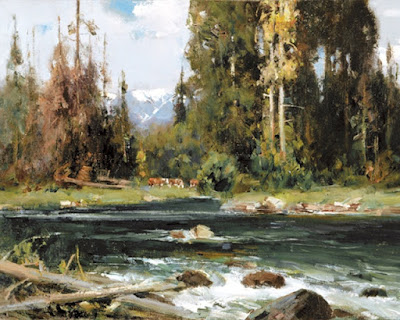The light and color of the southwest landscape captivate Margi Lucena and are the enduring subjects of her illustrative pastels on panel. Her intimate works convey an honest admiration for the desert, its rocks, canyons, cactus, trees, and skies. As she says, “I try to paint what I see and how I feel about the beauty of the natural landscape that surrounds us.” Painted mostly en plein air, Margi’s work empathetically details the characteristic qualities of light and shadow in the New Mexico landscape throughout all four seasons; the thin cold of winter and the lush heat of summer. Margi rapidly captures the shape of cool color in canyon shadows and the brevity of warm highlights on the edges of chamisa plants or cactus. With a fast and gutsy approach she achieves a rendering of the essential qualities that make the central and northern New Mexico environment particular and enchanting.
Margi’s alluring surfaces are texturally intriguing. Chalk pastels, her medium of choice, are pure pigment with minimal binder added, and display saturated color in a drawn mark; they are gritty and often gestural. The panels’ surfaces are further embellished with a toned and textured primer, allowing the chalk pastel to visually protrude from the flat surface. She frames her work soon after a piece is finished to protect it and intentionally uses the clearest anti-reflective glass that allows her colors to be viewed at their greatest intensity.
The impermanence of color and light as well as the fleetingness of the seasons are often the subject of Margi’s landscapes. Christine Proskow, who writes for the Pastel Journal, admires Lucena’s pastels and states that “No matter which season she seeks to portray, Lucena is adept in apprehending both the obvious and hidden beauty in the landscape around her…with a sensitivity that reveals her awe and fascination with her environment.” Many of the places she depicts are well-known landmarks in the New Mexico landscape, such as the Rio Grande Gorge near Taos and the distinctive ridges that surround Ghost Ranch, Georgia O’Keefe’s home and studio. She revisits several locations annually, such as the Bosque del Apache, to capture new color, new seasons, and a fresh take on the geography of the arid desert.
Margi has exhibited in numerous regional juried exhibitions, including the National Pastel Painting Competition. She is a Signature Member of the Pastel Society of New Mexico and in 2011/2012 won the Pastel Society of New Mexico National Competition. Margi Lucena resides in Socorro, NM.
Margi’s alluring surfaces are texturally intriguing. Chalk pastels, her medium of choice, are pure pigment with minimal binder added, and display saturated color in a drawn mark; they are gritty and often gestural. The panels’ surfaces are further embellished with a toned and textured primer, allowing the chalk pastel to visually protrude from the flat surface. She frames her work soon after a piece is finished to protect it and intentionally uses the clearest anti-reflective glass that allows her colors to be viewed at their greatest intensity.
The impermanence of color and light as well as the fleetingness of the seasons are often the subject of Margi’s landscapes. Christine Proskow, who writes for the Pastel Journal, admires Lucena’s pastels and states that “No matter which season she seeks to portray, Lucena is adept in apprehending both the obvious and hidden beauty in the landscape around her…with a sensitivity that reveals her awe and fascination with her environment.” Many of the places she depicts are well-known landmarks in the New Mexico landscape, such as the Rio Grande Gorge near Taos and the distinctive ridges that surround Ghost Ranch, Georgia O’Keefe’s home and studio. She revisits several locations annually, such as the Bosque del Apache, to capture new color, new seasons, and a fresh take on the geography of the arid desert.
Margi has exhibited in numerous regional juried exhibitions, including the National Pastel Painting Competition. She is a Signature Member of the Pastel Society of New Mexico and in 2011/2012 won the Pastel Society of New Mexico National Competition. Margi Lucena resides in Socorro, NM.

















































